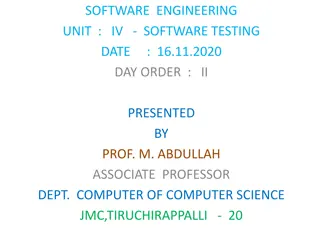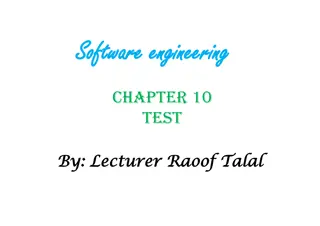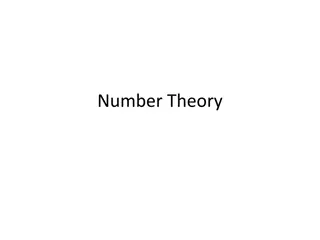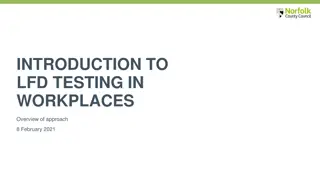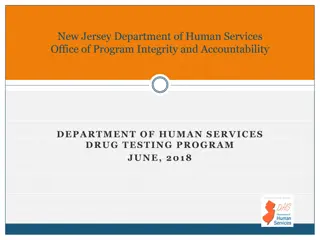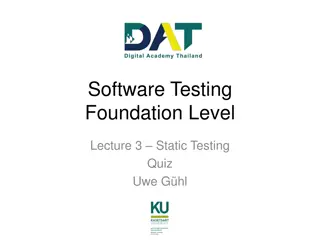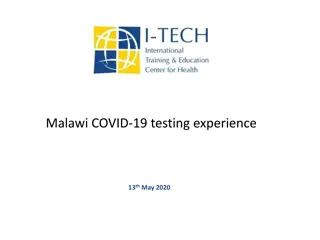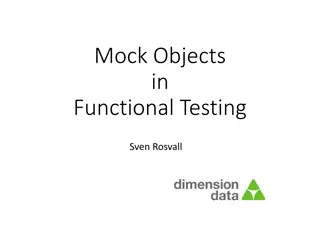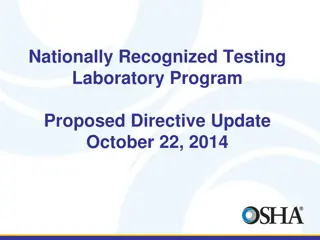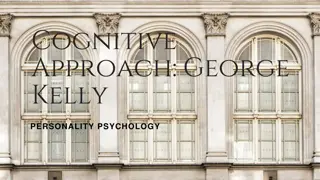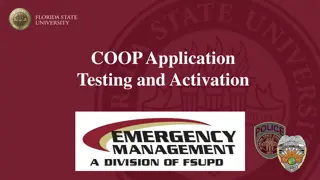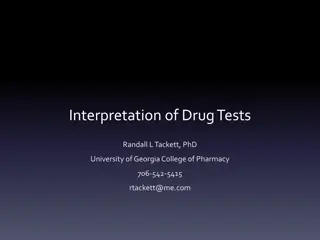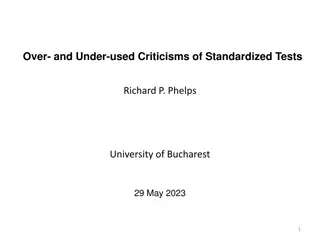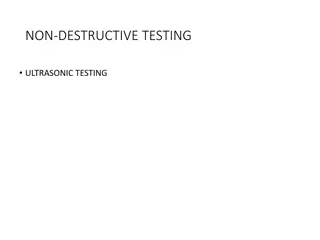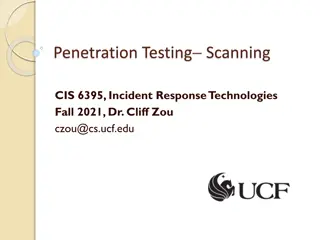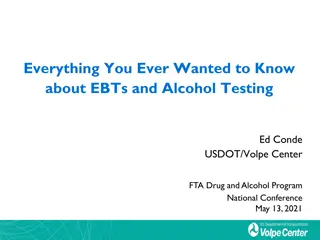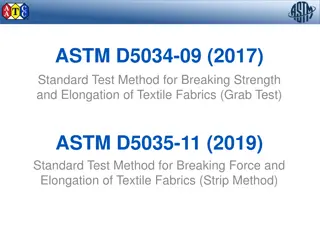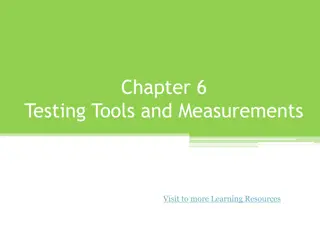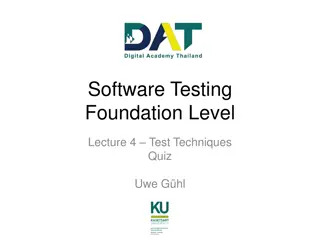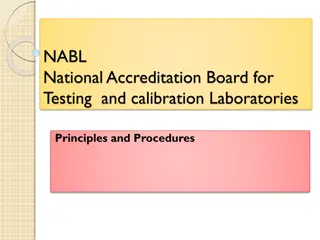Fundamentals of Program Testing Theory
Program testing theory emerged in the 1970s, focusing on detecting defects through test case design and selection strategies. Various testing theories like Goodenough and Gerhart's, Weyuker and Ostrand's, and Gourlay's offer insights into effective testing practices, emphasizing the limitations of testing in revealing errors. Concepts like ideal tests, test selection criteria reliability, and validity play key roles in designing thorough test cases.
Download Presentation

Please find below an Image/Link to download the presentation.
The content on the website is provided AS IS for your information and personal use only. It may not be sold, licensed, or shared on other websites without obtaining consent from the author. Download presentation by click this link. If you encounter any issues during the download, it is possible that the publisher has removed the file from their server.
E N D
Presentation Transcript
Chapter Three: Theory of Program Testing Sem. II - 2020 Department of Software Engineering ITSC-AAIT Dr. Sunkari Software Engineering II (Design, Verification and Validation) 1
Basic Concepts in Testing Theory The idea of program testing is as old as computer programming. In 1970, a new field of research called testing theory emerged. Testing theory puts emphasis on Detecting defects through program execution Designing test cases from different sources: requirement specification, source code, and input and output domains of programs Selecting a subset of tests cases from the entire input domain Effectiveness of test selection strategies Selection of Test oracles used during testing Prioritizing the execution of test cases Adequacy analysis of test cases Software Engineering II (Design, Verification and Validation) 2
Basic Concepts in Testing Theory A theoretical foundation of testing gives testers and developers valuable insight into software systems and development processes. As a consequence, testers design more effective test cases at a lower cost. Any testing theory must inherit the fundamental limitation of testing. The limitation of testing has been best articulated by Dijkstra: Testing can only reveal the presence of errors, never their absence. There are three well known testing theories: Theory of Goodenough and Gerhart (ideal test) Theory of Weyuker and Ostrand (uniformly ideal test) Theory of Gourlay (specifications first) Software Engineering II (Design, Verification and Validation) 3
Theory of Goodenough and Gerhart Fundamental Concepts Let P be a program, and D be its input domain. Let T D. P(d) is the result of executing P with input d. OK(d): Represents the acceptability of P(d). OK(d) = true iff P(d) is acceptable. SUCCESSFUL(T): T is a successful test iff t T, OK(t). Ideal Test: T is an ideal test if OK(t), t T => OK(d), d D. An Ideal test is interpreted as follows. If from the successful execution of a sample of the input domain we can conclude that the program contains no errors , then the sample constitutes an ideal test. Software Engineering II (Design, Verification and Validation) 5/4/19 4
Theory of Goodenough and Gerhart Test Selection Reliable Criterion: A test selection criterion C is reliable if either every test selected by C is successful, or no test selected is successful. Valid Criterion: A test selection criterion C is valid if whenever P is incorrect, C selects at least one test set T which is not successful for P. Fundamental Theorem ( T D) (COMPLETE(T,C) RELIABLE(C) VALID(C) SUCCESSFUL(T)) => ( d D) OK(d) Thorough test T is defined with exhaustive or complete test in which case T = D C defines the properties of a program that must be exercised to constitute a thorough test. Software Engineering II (Design, Verification and Validation) 5
Theory of Goodenough and Gerhart Theory of Testing Let C denote a set of test predicates. If d D satisfies test predicate c C, then c(d) is said to be true. COMPLETE(T, C) ( c C)( t T) c(t) ( t T)( c C) c(t) For every test predicate, we select a test such that the test predicate is satisfied. Also for every test selected there exists a test predicate w/c is satisfied by the selected test. Let s assume P fails on input d. In other words, the actual outcome of executing P with input d is not the same as the expected outcome, ? VALID(C) implies that there exists a complete set of test data T such that SUCCESSFUL(T). RELIABLE(C) implies that if one complete test fails, all tests fail. However, this leads to a contradiction that there exists a complete test that is successfully executed. OK(d) is true. Software Engineering II (Design, Verification and Validation) 6
Theory of Goodenough and Gerhart Finding a reliable and valid criterion enables to detect all faults with small set of test cases. However, this is impossible because of the following reasons. Faults in a program are unknown. A criterion is guaranteed to be both reliable and valid if it selects the entire input domain D. Neither reliability nor validity is preserved during the debugging process, where faults keep disappearing. If P is correct, Test selection criteria are reliable and valid. But if P is incorrect in general no way of knowing whether a criterion is ideal w/o knowing the errors in P. Software Engineering II (Design, Verification and Validation) 7
Theory of Goodenough and Gerhart Program Errors Any approach to testing is based on assumptions about the way program faults occur. Faults are due to two main reasons: Inadequate understanding of all conditions that a program must deal with. Failure to realize that certain combinations of conditions require special care. Goodenough and Gerhart classify program faults as follows: Logic fault (fault present in the program not because of the lack of the resource) Requirement fault - Fault of capture the real requirement of the customer Design fault - Failure to satisfy understood requirements Construction fault - Failure to satisfy the design Performance fault - leads to failure of the program to produce expected result within specified or desired resources limitation. Software Engineering II (Design, Verification and Validation) 8
Theory of Goodenough and Gerhart Sources of Faults Missing control-flow paths - A path may be missing from a program if we fail to identify a condition and specify a path to handle that condition (division by zero) Inappropriate path selection A program execute an Inappropriate path if a condition is expressed incorrectly Inappropriate or missing action Calculate a value using a method that does not necessarily give the correct result (Ex. Desired ? X=X*W , The Actual ? X=X+W , X= 1.5 , W=3) , Failing to assign a value to a variable or Calling a function with the wrong argument. Software Engineering II (Design, Verification and Validation) 9
Theory of Goodenough and Gerhart Conditions for Reliability of a set of test predicates C A set of test predicates must at least satisfy the following conditions to have any chance of being reliable Every branching condition must be represented by a condition in C. Every potential termination condition must be represented in C. Every condition relevant to the correct operation of the program must be represented in C. Drawbacks of the Theory Difficulty in assessing the reliability and validity of a criterion. The concepts of reliability and validity are defined w.r.t. a program. The goodness of a test should be independent of individual programs. Neither reliability nor validity is preserved throughout the debugging process. Software Engineering II (Design, Verification and Validation) 10
Theory of Weyuker and Ostrand They proposed the concept of a uniformly ideal test selection criterion for a given out put specification. d D is the input domain of program P and T D. OK(P, d) = true if P(d) is acceptable. SUCC(P, T): T is a successful test for P if t T, OK(P, t). Uniformly valid criterion: Criterion C is uniformly valid if ( P) [ ( d D)( OK(P, d)) => ( T D) (C(T) SUCC(P, T)) ]. Uniformly reliable criterion: Criterion C is uniformly reliable if ( P) ( T1, T2 D) [ (C(T1) C(T2)) => (SUCC(P, T1) <--> SUCC(P,T2)) ] Uniformly Ideal Test Selection A uniformly ideal test selection criterion for a given specification is both uniformly valid and uniformly reliable. Software Engineering II (Design, Verification and Validation) 11
Theory of Weyuker and Ostrand A subdomain S is a subset of D Criterion C is revealing for a subdomain S if whenever S contains an input which is processed incorrectly, then every test set which satisfies C is unsuccessful. In other word any test selected by C is successfully executed, then every test in S produces correct output. A predicate called REVEALING (C,S) REVEALING(C, S) if ( d S) ( OK(d)) => ( T S)(C(T) => SUCC(T)) Software Engineering II (Design, Verification and Validation) 12
Theory of Gourlay The theory assumes that the program specifications are correct, and the specification is the sole arbiter of the correctness of a program. The program is said to be correct if it satisfies its specification. Gourlay s theory aims to establish a relationship between three sets of entities namely specifications S, programs P, and Tests T. We can then extend the OK predicate as follows: OK (p, t, s) : The predicate is true if the result of testing p with t is judged to be successful with respect to specification s. We aim to make the predicate OK(p, t, s) true for every t in T, where t is a subset of T. In this context a program is correct with respect to its specifications denoted by CORR(p,s), if OK(p, s, t) for every t in T. Software Engineering II (Design, Verification and Validation) 13
Testing Systems A testing system is defined as a collection of <P, S, T, CORR, OK> for which for every p, s, t in P, S, T (where P, S, T are subsets of P, S, T P, S, T ) CORR(p, s) implies OK(p, s, t). 1. Set Construction System The set construction corresponds to a test that consists of a set of trials, and success of the test as a whole depends on the success of all trials. Failure of any one run is enough to invalidate the test. 2. Choice Construction System The choice construction models the situation in which a test engineer is given a number of alternative ways of testing the program, all of which is assumed to be equivalent. Software Engineering II (Design, Verification and Validation) 14
Test Methods A test method can be considered as a function M: P X S ? T That is, in the general case, a test method takes a program P, and a specification S, and produces test cases T (where P, S, T are subsets of P , S, T respectively). Test methods can be: Program Dependent T = M(P) ? (White Box Testing) Specification Dependent T = M(S) ? (Black Box Testing) Expectation Dependent T = M(S ), where S are the expectations of the customers, or the view the customers have on the specifications ? (Acceptance Testing) Software Engineering II (Design, Verification and Validation) 15
Power of Test Methods A fundamental problem in testing is to assess whether one test method is better than another (in recovering faults). Let M and N be two testing methods, and let FM, FNbe the faults that can be discovered by M and N respectively. For M to be at least as good as N, we must have the situation that whenever N finds a fault, so does M. In other words FNis a subset of FM. Let TNand TM, be the test cases produced by methods N and M respectively. The investigative power of methods N and M can be classified in two cases Case 1: TN TM.. In this case, method M is at least as good as method N Case 2: TN and TM overlap, but TN TM. This case suggests that TM does not totally contain TN and in order to compare their fault detection ability we execute program P under both test sets TN, TM. Let FN and FM be the sets of faults discovered by TN and TM. If FN FM then we say that method M is at least as good as N. Software Engineering II (Design, Verification and Validation) 16
Power of Test Methods Software Engineering II (Design, Verification and Validation) 17
Reading Kshirasagar Naik and Priyadarshi Tripathy, Software Testing and Quality Assurance - Theory and Practice , University of Waterloo, 2008. Page [32-46] And read other online references Software Engineering II (Design, Verification and Validation) 18










